

In this free gerunds and infinitives speaking activity, students ask and answer questions with gerunds and infinitives. First, students go through the items on the worksheet and form the questions they need to ask in order to do the activity, e.g. 'Do you love watching horror films?' Students then go around the class asking the questions to their classmates. When a classmate answers 'Yes, I do' to a question, the student writes their name and asks a follow-up question to gain more information, e.g. 'Why do you love watching horror films?' When everyone has finished, students use gerunds and infinitives to give feedback to the class on what they found out about their classmates.



This useful gerunds and infinitives worksheet helps students to learn and practice commonly used gerund and infinitive forms. Students begin with two gap-fill exercises where they complete sentences with gerunds and then infinitives. Next, students complete sentences with the gerund or infinitive form of the verbs in brackets. Lastly, students use their own ideas to complete sentences with gerunds and infinitives from the worksheet.



In this gerunds as a subject activity, students make sentences with gerunds as the subject and then use the gerunds to complete a crossword. Student A begins by choosing a verb from the box and saying it to Student B who listens and looks at the clues on their worksheet to find the sentence that needs the verb as a gerund. Student B then reads the complete sentence aloud with the gerund as the subject. If Student A agrees it's correct, Student B gives them the clue number and both students write the gerund in the crossword. When Student A has completed their part of the crossword, the two students swap roles. Finally, students check their answers by comparing crosswords and then discuss whether they agree or disagree with the sentences.
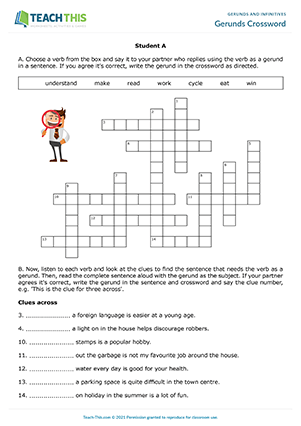


In this fun gerunds and infinitives activity, students write sentences about themselves with gerunds and infinitives and then play a guessing game using the sentences. Students complete sentences on their numbered worksheet with doing or to do. Students then respond to each item by writing a true sentence about themselves, e.g. 'I enjoy riding my mountain bike in my free time.' When everyone has finished, collect in the worksheets and then redistribute them. Students then take turns reading out the student number and sentences on their worksheet. Students start each sentence with 'This person…' and use the pronouns they and their, e.g. 'This person enjoys riding their mountain bike in their free time.' The other students write down the student number in their chart and listen to all the sentences. Students then try to guess the writer's identity, writing their guess next to the number in the chart. Afterwards, students reveal their numbers. Students score one point for each correctly identified student. The student with the most points wins the game.



In this gerunds and infinitives speaking activity, students complete sentences about themselves using gerunds and infinitives and then discuss them in small groups. First, students complete sentences with true information about themselves using a gerund or infinitive in each sentence. In groups, students then discuss their sentences and ask follow-up questions to keep the conversation going. Afterwards, students tell the class what they found out about their classmates..



In this insightful gerunds speaking activity, students talk about what they like doing at certain times. To start, students read through the worksheet and tick the option in each category that best describes what they like doing. Students can add their own answer if they wish using a gerund. Students then ask questions to their classmates to find a student who has the same interest as them in each category, e.g. 'What do you like doing in the morning?' When a student finds someone who likes doing the same thing, they write each other's names down and move on to speak to another student. When everyone has finished, students tell the class about their findings.
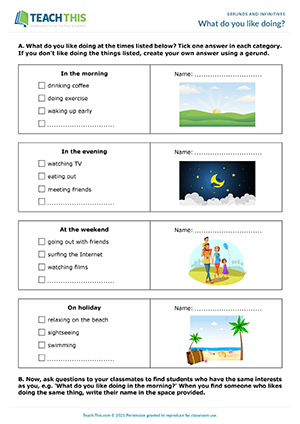


In this comprehensive verb patterns worksheet, students practice using verbs with gerunds and infinitives. In two groups, students look at a list of verbs and decide whether a gerund or infinitive comes after each one, writing G for gerund, I for infinitive, or E for either next to each verb. Next, tell both groups that they have the same paragraph texts but with different words missing. Students then complete the texts with the verbs, gerunds and infinitives shown. After that, students complete questions and answers about the text. Students then pair up with someone from the other group. Finally, students take turns asking the questions they wrote to their partner and replying to their partner's questions about the text.



Here is an engaging gerunds and infinitives game in which students create sentences with words and phrases that are followed by a gerund or infinitive. In groups, players take turns placing a set A card and a set B card from their hand on the table and making a sentence with a gerund or infinitive by combining the words on the cards together. For example, if a Set A card had the word 'refuse' and a Set B card had the word 'walk', a player might say, 'I refuse to walk to school.' If a player successfully makes a sentence, they put the two cards aside and replace the cards by taking one from each pile. If not, the player takes the cards back. If a player cannot make a sentence, they use their turn to change one of their cards. The player with the most pairs of cards at the end of the game is the winner.



In this free gerunds and infinitives speaking activity, students answer questions and discuss various topics using gerunds and infinitives with to. In groups, students take turns picking up a card, reading the question to the group, and starting a discussion using a gerund or infinitive. For example, if the question was 'What would you like to learn how to do?', the student might say, "I would like to learn how to cook because. " All the group members then give their answers and discuss the topic, giving as much information as possible to keep the conversation going. When the groups have finished, they give feedback to the class on some of the things they discussed.
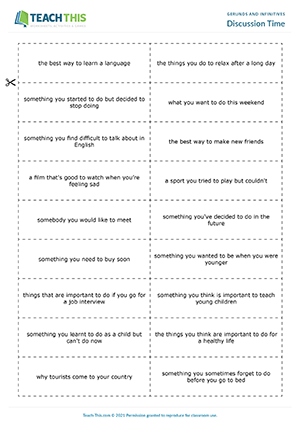


In this gerunds and infinitives true or false board game, students practice making statements and questions with gerunds and infinitives. Students place their counters on the start square. Students then take turns rolling the dice and moving their counter along the board. When a student lands on a square, they pick up a true or false card from the pile and look at it, without showing anyone. The student then makes a statement with a gerund or infinitive using the prompt on the square, giving either true or false information as indicated on the card, e.g. 'I plan to go abroad next month.' The other students then ask questions using the gerund or infinitive to determine if the student is lying or telling the truth, e.g. 'Where do you plan to go?' After a few questions have been answered, the group members guess whether the student's answer is true or false. The student then reveals the answer. The group members who guessed correctly each score one point. The next student then rolls the dice, and so on. When a student reaches the finish, the game ends and the points are added up. The student with the most points wins the game.



In this gerunds and infinitives game, students match verbs with gerunds and infinitives and make sentences with them. The first player puts a domino down either before or after the domino on the table, making sure the verb in bold matches with the gerund or infinitive, or vice-versa. The player then makes a sentence with the verb and gerund or infinitive to show the match is correct. The next player then tries to put down one of their dominoes at either end of the domino chain, and so on. If a player can't think of a sentence, makes a grammar mistake or matches the dominoes incorrectly, the player takes back the domino and play passes to the next student. The first player to get rid of all their dominoes wins the game.



Here is a compelling gerunds and infinitives worksheet to test students' knowledge of gerunds and infinitives with to. First, students complete each sentence with the verb in brackets in its gerund or infinitive form. Students score one point for each correct answer. Finally, students check their scores to see how well they know gerunds and infinitives.
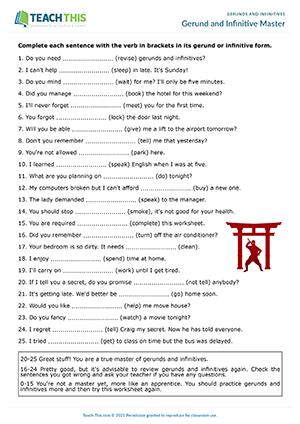


This productive verb patterns worksheet helps students practice or review gerunds and infinitives. First, students complete sentences with the gerund or infinitive form of the verbs in brackets. Students then choose the correct gerund or infinitive forms in a set of sentences. Next, students use gerunds and infinitives to complete sentences with true information about themselves. Lastly, students discuss their sentences with a partner.



In this interesting gerunds activity, students try to write true sentences about their classmates and then check if their sentences are true or not by asking questions. Students start by writing the name of each student in the class in the first column of the worksheet. Students then try to write a true sentence about each person using the verb next to their name followed by a gerund, e.g. 'Charlie likes getting up late at the weekend.' When the students have finished, they find out if their sentences are true or not by asking questions to the people on their worksheet, e.g. 'Charlie, do you like getting up late at the weekend?' If a sentence is true, students put a tick in the last column. If it's not, students put a cross. The student with the most true sentences wins.
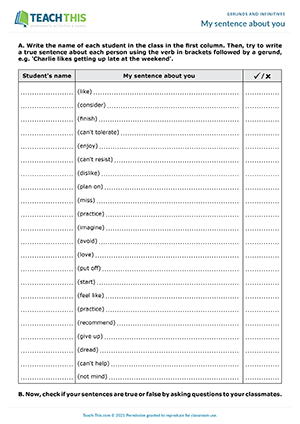


In this enjoyable gerunds and infinitives speaking activity, students complete sentences about themselves with true information and then find classmates who are the same. First, students complete each sentence with true information about themselves using a gerund or infinitive. Next, students read their sentences to their classmates and try to find one person for each sentence who is the same as them, e.g. 'At the weekend, I enjoy playing tennis.' If a classmate is the same, they say 'Same here'. The student then writes their name in the 'Same here!' column next to the sentence. When the students have finished, they give feedback to the class on what they found out.



Here is a free gerunds and infinitives speaking activity for students to do in class. In pairs, students take turns asking their partner to tell them about the things listed on their worksheet, e.g. 'Tell me about something you want to do in the future.' Each response requires a gerund or infinitive in the answer. To keep the conversation going, students ask follow-up questions when possible. Afterwards, students give feedback to the class on what they found out about their partner.



In this memorable gerunds and infinitives game, students try to guess true information about a partner using gerunds and infinitives. First, students think about their partner and complete sentences by guessing true information about them. Students must use a gerund or infinitive in each sentence. Students then take turns reading each sentence to their partner, who listens and tells them if it is true or not. For each correct guess, students score one point. If a sentence is untrue, their partner gives the real answer. The student with the most points at the end of the game wins.
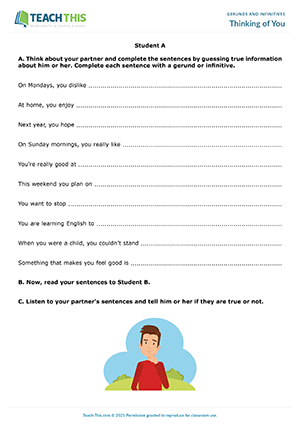


In this creative gerunds board game, students complete sentences with a gerund or gerund phrase. The sentences focus on the expressions (not) worth. and (no) point... to show the (lack of) usefulness or value of an action or suggestion. In groups, players take turns rolling the dice and moving their counter along the board. When a player lands on a sentence square, they complete the sentence with an appropriate gerund or gerund phrase. Each gerund that players use must be unique. The player then writes the gerund on a piece of paper. If a player accidentally uses a gerund twice or makes a grammar mistake, they move back three spaces. The first player to reach the finish is the winner.
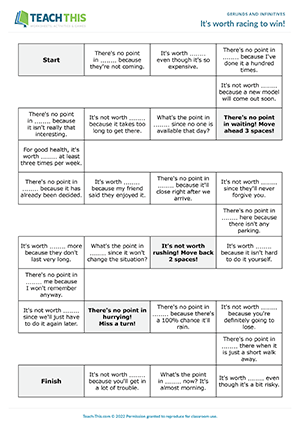


In this Connect 4 style gerunds grammar game, students practice talking about past plans and intentions using thinking of and gerund phrases. In pairs, players take turns choosing a square and forming a sentence using thinking of with the indicated time adverbial and person or people, e.g. 'I was thinking of moving to Sweden after I left school, but I ended up going to Japan instead.' The player then writes the gerund phrase (e.g. moving to Sweden) in the square. The first player to get four squares in a row wins. If you want to give the students more practice, you can ask them to make only true statements and then discuss each statement before moving on to the next player's turn.



In this free gerunds and infinitives game, students write true and false statements about themselves and then play a true or false guessing game with the statements. Each student has six verb cards. First, students write three statements for each verb, one true statement and two false. All the verbs must be followed by a gerund or infinitive. Students then take turns reading three statements to the group. Each time three statements are read out, the group members ask the student questions to help them decide which statement is true. When the group members have each decided which statement is true, the student reveals the correct answer. Students that guessed correctly each score a point. The student with the most points at the end of the game is the winner.